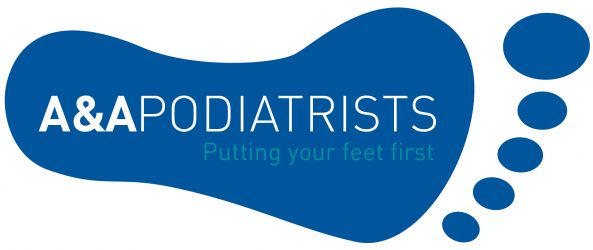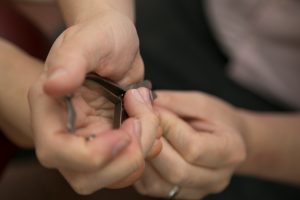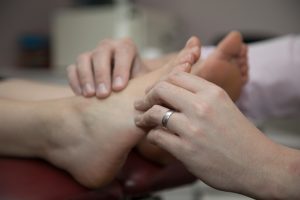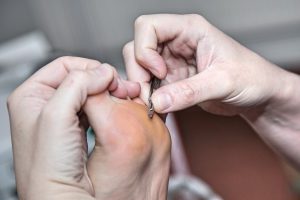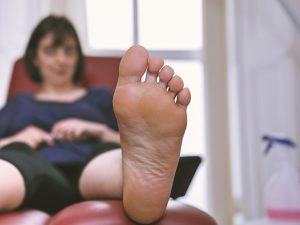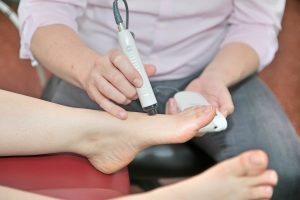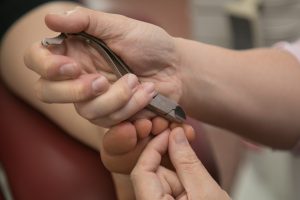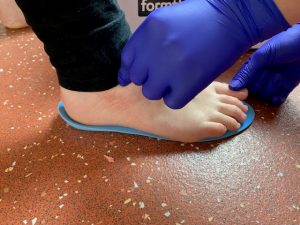Information about our treatments
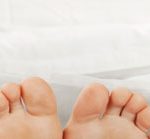
General Podiatry
A large proportion of our practice is involved with general podiatry treatment. This typically involves a combination of medical and cosmetic treatments to the feet.
Many people develop foot problems because of the way they walk, the structure of their feet, skin type, their footwear, occupation or activities as well as how they care for the feet themselves.
General podiatry involves the removal of hard skin (callus), heel fissures, corns as well as the cutting and filing of toenails, thinning them where thick or ridged as well as clearing the build up of debris and skin from the edges.
Why remove corns and callus?
Our skin responds to the pressure and friction applied to it. On the feet, the forces are often 3-5 times our body weight and the effect of footwear or hard surfaces causes thickening of the skin which continues to form. This causes callus (yellow patches of skin), corns (hard stones of skin) or fissures (cracks in the skin). All of these can be treated during a general podiatry treatment improving both the comfort and the appearance.
Corns may form on bony prominences – often the toes or ball of foot – where the knuckle presses against the shoe.
Nails can become difficult to cut if they become thick for brittle as well as other factors such as eyesight, weight, strength and dexterity.
The Procedure
Treatment to remove hard skin, corns and treat nails is customised to both a patients requirements and requests. During a treatment, priority is given to areas that are painful or at risk of becoming sore or open. Areas of hard skin that are not causing a problem may be left since they are protective (e.g. for sports or running), whilst in other cases where the appearance is more important they are removed (e.g. before a holiday).
- Your general health and foot condition is assessed as well as your footwear and activities. Questions about areas of pain or discomfort are ascertained and the areas of treatment agreed.
- The feet are sprayed with antiseptic spray and a sterile set of instruments opened.
- Nails are cut with two different shapes of nail clipper according to the shape, filed with a water file and the sides rounded and cleared
- The callus is removed with a sterile blade applied almost parallel to the skin to remove the thick skin in a controlled and precise manner. Different shaped blades are used according to the location and skin type. Corns are gently prised out since they are like a stone. The water file can also be used to smooth and remove the hard skin and corns too. Different shaped burrs are used accordingly.
- If needed pads or dressings may be applied to protect areas of the foot further, and advice given to help maintain the feet.
- A repeat appointment discussed at an appropriate time frame. This may be anywhere from an annual check up to every 4 weeks depending on the severity and foot type.
Generally speaking nails keep growing and we keep walking on our feet causing hard skin and corns to form on the pressure and friction points. General podiatry treatments acknowledges this fact and whilst preventative advice is discussed, it is not always entirely possible to eliminate the excess pressure on the feet or find the perfect shoes or correct the foot shape!
Fungal Nail Treatment
A large proportion of our practice is involved with general podiatry treatment. This typically involves a combination of medical and cosmetic treatments to the feet.
Many people develop foot problems because of the way they walk, the structure of their feet, skin type, their footwear, occupation or activities as well as how they care for the feet themselves.
General podiatry involves the removal of hard skin (callus), heel fissures, corns as well as the cutting and filing of toenails, thinning them where thick or ridged as well as clearing the build up of debris and skin from the edges.
Why remove corns and callus?
Our skin responds to the pressure and friction applied to it. On the feet, the forces are often 3-5 times our body weight and the effect of footwear or hard surfaces causes thickening of the skin which continues to form. This causes callus (yellow patches of skin), corns (hard stones of skin) or fissures (cracks in the skin). All of these can be treated during a general podiatry treatment improving both the comfort and the appearance.
Corns may form on bony prominences – often the toes or ball of foot – where the knuckle presses against the shoe.
Nails can become difficult to cut if they become thick for brittle as well as other factors such as eyesight, weight, strength and dexterity.
The Procedure
Treatment to remove hard skin, corns and treat nails is customised to both a patients requirements and requests. During a treatment, priority is given to areas that are painful or at risk of becoming sore or open. Areas of hard skin that are not causing a problem may be left since they are protective (e.g. for sports or running), whilst in other cases where the appearance is more important they are removed (e.g. before a holiday).
- Your general health and foot condition is assessed as well as your footwear and activities. Questions about areas of pain or discomfort are ascertained and the areas of treatment agreed.
- The feet are sprayed with antiseptic spray and a sterile set of instruments opened.
- Nails are cut with two different shapes of nail clipper according to the shape, filed with a water file and the sides rounded and cleared
- The callus is removed with a sterile blade applied almost parallel to the skin to remove the thick skin in a controlled and precise manner. Different shaped blades are used according to the location and skin type. Corns are gently prised out since they are like a stone. The water file can also be used to smooth and remove the hard skin and corns too. Different shaped burrs are used accordingly.
- If needed pads or dressings may be applied to protect areas of the foot further, and advice given to help maintain the feet.
- A repeat appointment discussed at an appropriate time frame. This may be anywhere from an annual check up to every 4 weeks depending on the severity and foot type.
Generally speaking nails keep growing and we keep walking on our feet causing hard skin and corns to form on the pressure and friction points. General podiatry treatments acknowledges this fact and whilst preventative advice is discussed, it is not always entirely possible to eliminate the excess pressure on the feet or find the perfect shoes or correct the foot shape!
Verruca Treatment
Verrucae are warts in the foot. They are problematic because it takes time before they are noticed but also the skin is thicker on the feet and pressure do walking pushes them into the skin.
There is no one treatment that works for everyone and treatment can be unpredictable.
Verrucae and warts are caused by the human papilloma virus (HPV). The virus lives in the body’s cells making it difficult for the immune system to identify and react.
Treatment aims to either stimulate the immune system into reacting or destroys the skin containing the virus.
How are verrucae treated?
Various acids are applied – commonly salicylic acid but at a higher concentration than in bazooka! Alternatively we could freeze it with Dermafreeze which freezes the area to -59. Our YAG laser has also exhibited antiviral activity. We also can use a surgical technique called curettage to cut out single verrucae.
In all cases we will discuss the treatment suitable in your case and devise a sensible plan of attack!
Many people develop foot problems because of the way they walk, the structure of their feet, skin type, their footwear, occupation or activities as well as how they care for the feet themselves.
General podiatry involves the removal of hard skin (callus), heel fissures, corns as well as the cutting and filing of toenails, thinning them where thick or ridged as well as clearing the build up of debris and skin from the edges.
The Procedure
Treatment to remove hard skin, corns and treat nails is customised to both a patients requirements and requests. During a treatment, priority is given to areas that are painful or at risk of becoming sore or open. Areas of hard skin that are not causing a problem may be left since they are protective (e.g. for sports or running), whilst in other cases where the appearance is more important they are removed (e.g. before a holiday).
- Your general health and foot condition is assessed as well as your footwear and activities. Questions about areas of pain or discomfort are ascertained and the areas of treatment agreed.
- The feet are sprayed with antiseptic spray and a sterile set of instruments opened.
- Nails are cut with two different shapes of nail clipper according to the shape, filed with a water file and the sides rounded and cleared
- The callus is removed with a sterile blade applied almost parallel to the skin to remove the thick skin in a controlled and precise manner. Different shaped blades are used according to the location and skin type. Corns are gently prised out since they are like a stone. The water file can also be used to smooth and remove the hard skin and corns too. Different shaped burrs are used accordingly.
- If needed pads or dressings may be applied to protect areas of the foot further, and advice given to help maintain the feet.
- A repeat appointment discussed at an appropriate time frame. This may be anywhere from an annual check up to every 4 weeks depending on the severity and foot type.
Generally speaking nails keep growing and we keep walking on our feet causing hard skin and corns to form on the pressure and friction points. General podiatry treatments acknowledges this fact and whilst preventative advice is discussed, it is not always entirely possible to eliminate the excess pressure on the feet or find the perfect shoes or correct the foot shape!
Verrucae are warts in the foot. They are problematic because it takes time before they are noticed but also the skin is thicker on the feet and pressure do walking pushes them into the skin.
